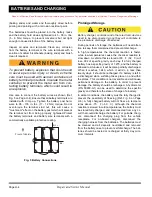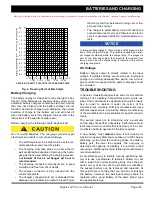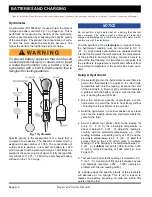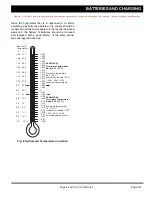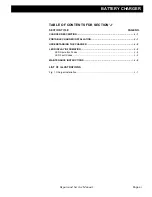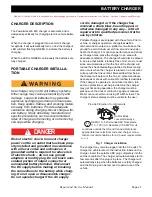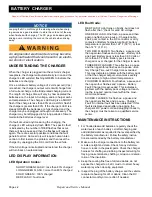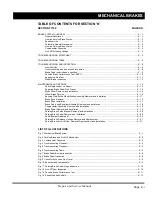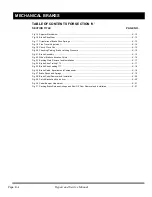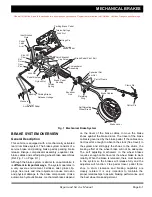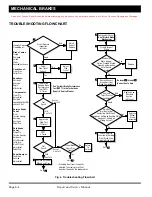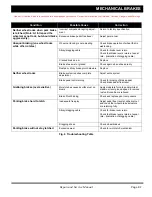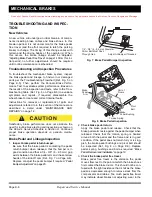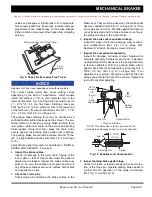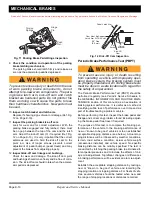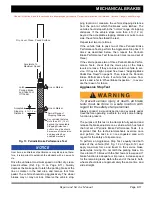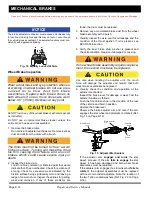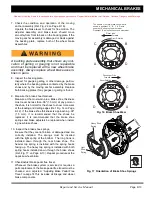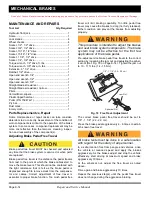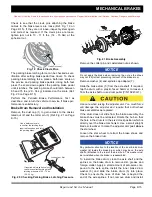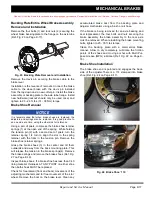
Page K-2
MECHANICAL BRAKES
Repair and Service Manual
Read all of Section B and this section before attempting any procedure. Pay particular attention to all Notices, Cautions, Dangers and Warnings..
How the Service Brake Works
Depressing the service brake pedal pulls the compensa-
tor assembly and equalizer link, which are connected to
the brake cables (Ref. Fig. 1 on Page K-1). The first part
of the pedal travel removes slack from the system. Con-
tinued motion of the brake pedal pulls both the left and
right brake cables. Each brake cable pulls a brake lever
which pushes the rear brake shoe against the brake
drum. When the rear shoe contacts the brake drum, it
can no longer move rearward. Additional pedal (and
cable) travel causes the actuator bracket (moving
anchor) to move and applies force to the front shoe,
pushing it against the brake drum. The force applied to
the front and rear shoes is approximately equal. As the
shoes contact the moving brake drum, the shoes try to
move in the direction of drum rotation. This movement
results in the typical brake shoe wear patterns.
Equalizer Link
The equalizer link balances braking between the driver
and passenger sides of the vehicle. Variations in wheel
brake adjustment, cable friction and manufacturing toler-
ances may cause the equalizer to be slightly misaligned.
This misalignment is normal.
Automatic Adjuster Mechanism
Never manually adjust the brakes at the star wheel. Doing
so will cause permanent damage to the adjuster assem-
bly and result in a gradual loss of brakes.
The wheel brakes are equipped with an automatic
adjuster mechanism that is designed to compensate for
brake shoe wear and eliminate the need for manual
brake shoe adjustment. The brake adjuster is activated
by movement of the lever attached to the brake cable.
How the Parking Brake Works
The parking brake is operated by a smaller pedal which
extends across the top of the service brake pedal. It is
attached to the service brake pedal with a hinge pin and
is spring loaded (Ref. Fig. 2 on Page K-2).
Depressing the parking brake pedal moves the latch arm
against the catch bracket attached to the chassis. As the
parking brake is depressed, the service brake is applied
until the notch in the latch arm engages with the catch
bracket. The service brake pedal is held in the applied
(down) position by the catch bracket.
Fig. 2 Parking Brake and Kick-Off Mechanism
The latch arm is held in position by the tension in the
brake linkage. The Parking Brake can be released by
two methods:
1. Depressing the service brake, which permits the
spring loaded Parking Brake pedal to return to its orig-
inal position, disengaging the latch arm from the catch
bracket. This is the preferred method which minimizes
wear on components.
2. Pressing the accelerator pedal rotates the kick-off cam
which forces the pedal latch arm to move away from
the catch bracket. The spring loaded Parking Brake
pedal returns to its original position, releasing the
brake.
Pedal
Latch
Arm
Accelerator
Pedal
Pedal Latch Arm
Kick-Off Cam
Pedal Bumper
Catch
Bracket

